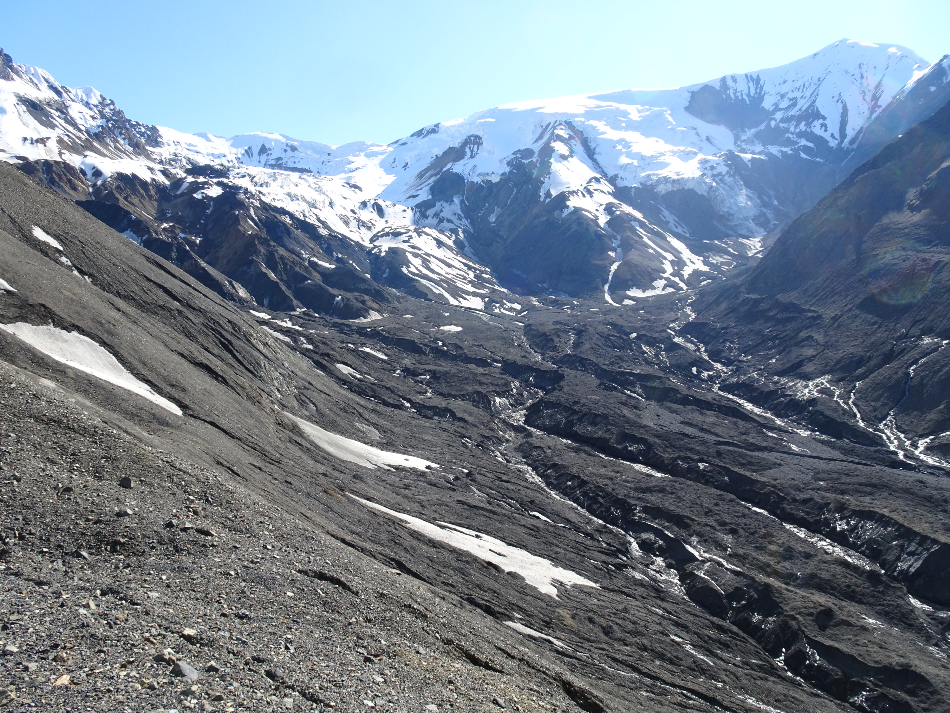Apr 29 2020
A surprising event took place deep in the remote interior area of the largest national park in the United States, on the evening of August 5th, 2013.
 View into the detachment zone: Flat Creek glacier used to occupy the central trough visible in the image. Within just a few years, the surrounding ice flowed into space previously filled by the glacier, masking the full extent of the damage left by the detachments. Wrangell–St. Elias National Park and Preserve. Image credit: Mylène Jacquemart.
View into the detachment zone: Flat Creek glacier used to occupy the central trough visible in the image. Within just a few years, the surrounding ice flowed into space previously filled by the glacier, masking the full extent of the damage left by the detachments. Wrangell–St. Elias National Park and Preserve. Image credit: Mylène Jacquemart.
In Alaska’s flat creek glacier, a half-kilometer-long tongue broke off unexpectedly, discharging a flood of rock and ice that gushed 11 km down a rough mountain valley into the dark woods surrounded by Wrangell–St. Elias National Park and Preserve.
In 2015, Michael Loso, a National Park Service geologist, recorded a similar event in the same area. He recruited Mylène Jacquemart, a PhD student at the University of Colorado Boulder, for further investigation.
We were aware of glacier detachments that had happened in Tibet, Russia, and Argentina, but started out thinking we were investigating a regular landslide. Then we noticed that the entire glacier was missing.
Mylène Jacquemart, PhD Student, University of Colorado Boulder
The findings of the study, which were published in the Geology journal, suggest that the Alaskan detachments took place during the peak summer melt seasons and indicate that such highly detrimental events could happen very often in a warming world.
Following a preliminary study by Michael Loso, a seismic trigger for such events was ruled out, after which he, Jacquemart, and other researchers started a research project to examine what had occurred at Flat Creek.
The researchers employed a range of tools, such as meltwater modeling, digital elevation models, field measurements, and satellite imagery to put the sequence of events together.
This project was a real sleuthing challenge, and the pieces finally fell into place when we discovered the bulge on the Flat Creek glacier.
Mylène Jacquemart, PhD Student, University of Colorado Boulder
The team knew that an odd ice bulge was present on the tongue of the glacier before the initial detachment in 2013. However, only after they achieved 10-year-old, high-resolution satellite images and predicted that the bulge was a splendid 70 m high, they started realizing its consequences.
Our data indicate that the lowermost part of the glacier tongue was very thin, stagnant, and firmly frozen to the glacier bed. We believe this frozen tongue did two things: it blocked ice flowing down from higher on the glacier, forcing it to bulge; and it slowed meltwater drainage, allowing the water to pool under the glacier.
Mylène Jacquemart, PhD Student, University of Colorado Boulder
According to Jacquemart, the resulting rise in subglacial water pressure ultimately led to the sudden detachment of the glacier tongue, causing two very large mass flows that each buried about 3 km2 of the forest that is four centuries old.
Jacquemart feels that glaciers are mainly vanishing due to the melting of ice at a faster pace.
“But the new insights we’re gaining from places like Flat Creek show that we also need to consider new processes we weren’t previously aware of,” added Jacquemart.
Jacquemart noted that eventually, researchers would have to gain better insights into these new processes and possibly review risk evaluations in mountain communities.
According to Jacquemart, “Flat Creek is fortunately in a very remote place, but the detachments that occurred in Russia and Tibet claimed numerous lives. Suddenly, a remote event can have far-reaching impacts downstream.”
Considering that the mass flows generated by glacier detachments seem to move a long way, emergency planners must also keep in mind the probable cascading dangers, like the short-lived damming of a river followed by the release of water, added Jacquemart.
The analogous nature of the glacier detachments in Alaska and those that took place in Tibet indicates that all such events had a common reason. Also, researchers have recently identified other detachments in other parts of the world, stated Jacquemart, indicating that large-scale glacier detachments may increase due to global warming.
Jacquemart stated, “We conclude that the meltwater produced by increasingly warmer summers has the potential to create unexpected consequences in the form of hazards that we didn’t previously know about, and that we are only just beginning to understand.”
Journal Reference:
Jacquemart, M., et al. (2020) What drives large-scale glacier detachments? Insights from Flat Creek glacier, St. Elias Mountains, Alaska. Geology. doi.org/10.1130/G47211.1.